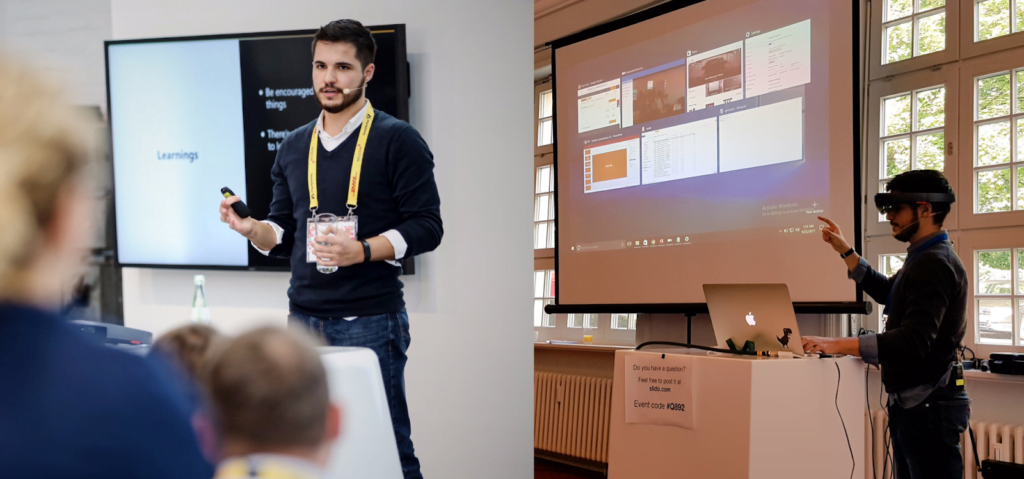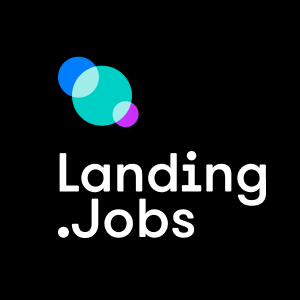
Presenting a AR/VR app he developed in his free time in 2 conferences across Germany (October / 2017)
Luis has been living in Munich for the last 5 years, and for the past 1 and a half he’s been working at Celonis as a Senior Frontend Engineer. Originally from Brazil, he moved to Germany for work and never left since. When he’s not coding for Celonis, he plays around with the four 3D printers he has at home and develops VR applications for fun!
How a kid who was curious about electronics became a designer who then became a developer
A burning eagerness to learn
Luis was born curious by nature — his room as a child would often look like a war field because he disassembled most of his toys to see how they worked on the inside. So much so, he didn’t wait until it was time to go to college to learn about electronics — when he was 15 he enrolled and then graduated from a 2-year course in a well-known Institute in Brazil. It was there that he started learning algorithms and programming, and even took part in a “WorldSkills Olympic Games” for which he earned 4th place (fruit of a lot of training hours in his free time).
It was this thirst for knowledge and keenness in challenging himself that led him to learn technical skills from a very young age. However, he decided to shift to design when it was time to enter college at 17. The reason for that being he “was (…) burnt-out by the engineering calculations involved in the electronics field”.
The first job
While in college, Luis landed an internship in a digital agency as a “graphic designer art assistant”, where chance had him helping out the development team solve and implement some challenges introduced by the design team itself. This help became a recurrent thing and before he knew it he was promoted to a full-time web developer role in the agency.
(…) that’s where the shift started. I realized that I was now a bridge between the design and development worlds.
The big move to Europe
When Luis received an offer to work in Berlin, he didn’t need to think twice. A previous visit to Munich left him deeply attracted to Germany. He started working for a REWE Group child-company where he had the opportunity to “build from scratch a project that exists until these days to help all designers, developers and stakeholders to “communicate” in a better way: a design system”.
My only surprise when I initially moved to Berlin was the fact that it looks like a completely different place than the rest of Germany. It was a bit of a cultural shock until I got used to it a few months later.
Fast-forward 6 months, he got an offer from the same company to move to Munich for a project (talk about good timing). His only complaint is that supermarkets and stores close at 8PM — we feel you 🤪.
And then Celonis happened
After 3 years this “baby project” was now an “adult being able to walk on its own”. So I moved to another company to do it over again. There I was able to achieve roughly a good result in a year and a half.
After working on projects with different levels of complexity, Luis wanted to take it even further. He knew Celonis had a very wide variety of UI components, as well as a very solid product: when the pandemic started, a tool such as process mining could help companies reduce costs and would definitely make the world a better place.
Today, the thing he loves most about working at Celonis is the fact that he can’t imagine himself getting bored. According to him “there’s always something challenging (in a good way) to work on”. And one of the great perks? Being given 10% of their time to work on ANY project they like.
From time to time there are company-wide creativity contests where anyone can participate and win prizes (usually it’s a charity donation — and worth having some fun participating while helping out the ones in need).
Remote Work
Ever since joining Celonis, Luis has been working fully remote due to the pandemic, only stopping by the office occasionally to pick up his meal passes. He told us it was challenging in the beginning not to see people’s faces (same!), but fortunately they’ve had the chance to meet occasionally (and safely) ever since the restrictions got lifted a little.
A typical work day
When asked how to describe his role as a Frontend Engineer, Luis said: “We’re the professionals behind bringing a design concept and backend data to “life”. A Frontend Engineer at Celonis thrives for providing the best user experience as possible, while keeping in mind performance and code best practices”.
Regarding a typical work day, it depends on the team/part of the product one is working on. According to him, every team has the freedom to organize themselves as they please, and in his current team everyone’s autonomous.
We are currently working on a new feature that is definitely making user’s daily work lives better. We make sure that we understand the user’s daily needs and implement them in a useful way. That means that we go on brainstorming for solving challenges almost on a daily basis. The interaction with designers is not linear (they work on it first and then delegate to us) but rather iterative — we work on things together since the beginning, and revisit it over and over if necessary. That keeps us in a close relationship/loop, which really makes us stronger in the long term, avoiding most of the times the need of rework.
But Luis isn’t only a Frontend Engineer, he’s also a user consuming digital products, which drives him to create a great product. He focuses on creating the right product for everyone: “We take user research seriously, and I enjoy taking part in it to test what we develop and get earlier feedback. The challenges rely mostly on providing a cutting edge end-user feature using modern technologies while keeping developer experience clean and pleasant”.
Word to the wise
When asked what he thinks a Frontend Engineer would need to succeed in their career, Luis started by highlighting the technical skills that are most important. According to him, one should “start from the basics and learn about programming logic, algorithms, and data structures”, which are a good foundation for the next steps into learning one or more web development languages like HTML, CSS and Javascript. He’s not wrong when he says it will open doors to then learn how to use any one of the most common frameworks/libraries used on the market today. Also, “having a good grasp on design theories can also be very helpful to help understanding how things work”.
Personality-wise I think it’s very helpful to be overall curious, and problem-solving driven. Having good interpersonal and communication skills definitely makes a difference.
And the bottom line: “never stopping learning is the secret sauce”. With new technologies coming almost on a daily basis in this world, it’s incredibly important to be up to date.
If you would like to become a (Senior) Frontend Engineer, you have to practice until you can perfect it. Start small, be humble, ask questions and show passion. The rest will come. At the end of the day, being bad is the first step to being better.
We couldn’t have said it better. We hope Luis’ career journey has given you some insights about working in tech, especially as a developer, and has inspired you to keep learning and challenging yourself. Celonis is currently hiring, so take the chance to look at their job openings if you’d like to join them 🙂 They are hiring both in Germany and Spain!






0 Comments